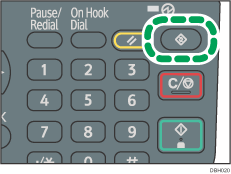Press the [User Tools] key, and then select the setting items using the [![]() ] or [
] or [![]() ] key.
] key.

![]() Select [System Settings]
Select [System Settings] ![]() Press [OK]
Press [OK]
![]() Select [Administrator Tools]
Select [Administrator Tools] ![]() Press [OK]
Press [OK]
![]() Select [Prog/Chnge/Del LDAP Server]
Select [Prog/Chnge/Del LDAP Server] ![]() Press [OK]
Press [OK]
![]() Select [Program/Change]
Select [Program/Change] ![]() Press [OK]
Press [OK]
![]() Select the LDAP server you want to program or change
Select the LDAP server you want to program or change ![]() Press [OK]
Press [OK]
When programming a new server, select [*Not Programmed].
![]() Select [Name]
Select [Name] ![]() Press [OK]
Press [OK]
![]() Enter the name
Enter the name ![]() Press [OK]
Press [OK]
![]() Select [Server Name]
Select [Server Name] ![]() Press [OK]
Press [OK]
![]() Enter the server name
Enter the server name ![]() Press [OK]
Press [OK]
Enter either the host name or IPv4 Address of the LDAP server within 128 characters.
![]() Press [Search Base]
Press [Search Base] ![]() Press [OK]
Press [OK]
Select a root folder to start a search. E-mail addresses registered in the selected folder are search targets.
![]() Enter the search base
Enter the search base ![]() Press [OK]
Press [OK]
For example, if the search target is the sales department of ABC company, enter "dc=sales department, o=ABC". (In this example, the description is for an active directory. "dc" is for the organization unit, and "o" is for the company.)
Search base registration may be required depending on your server environment. When the registration is required, unspecified searches will result in error.
Check your server environment and enter any required specifications.
![]() Select [Port No.]
Select [Port No.] ![]() Press [OK]
Press [OK]
Specify a port number for communicating with the LDAP server. The port must be compliant with your environment.
![]() Enter the port number
Enter the port number ![]() Press [OK]
Press [OK]
![]() Select [SSL]
Select [SSL] ![]() Press [OK]
Press [OK]
![]() Select [On]
Select [On] ![]() Press [OK]
Press [OK]
Use SSL to communicate with the LDAP server.
For SSL to function, the LDAP server must support SSL.
If you set SSL to [On], the port number automatically changes to "636".
If you do not enable SSL, security problems may occur. To enable SSL, you must use the machine's settings. For details, see Security Guide.
![]() Select [Authentication]
Select [Authentication] ![]() Press [OK]
Press [OK]
![]() Select an authentication method
Select an authentication method
To make a search request to the LDAP server, the administrator account can be used for authentication.
Authentication settings must comply with your server's authentication settings. Check your server settings before setting this machine.
[Kerberos Authentication]
A password protected with encryption is sent to the KDC server where authentication is performed.
[Digest Authentication]
A password protected with encryption is sent to the LDAP server.
Digest Authentication is only available with LDAP version 3.0.
[Cleartext Authentication]
A password without encryption is sent to the LDAP server.
![]() Enter the user name
Enter the user name ![]() Press [OK]
Press [OK]
When [Kerberos Authentication], [Digest Authentication], or [Cleartext Authentication] is selected for the authentication setting, the administrator account name and password can be used. Do not enter the administrator account name and password when using authentication for each individual or each search.
Procedures for the user name setting differ depending on the server environment. Check your server environment before making the setting.
Example: Domain Name\User Name, User Name@Domain Name, CN=Name, OU=Department Name, DC=Server Name
![]() Enter the password
Enter the password ![]() Press [OK]
Press [OK]
The user name and password are required to access the LDAP server.
You can connect to the LDAP server using a user name and password stored in the Address Book.
If you select [Digest Authentication] or [Cleartext Authentication], proceed to Step 21.
![]() Select the Realm
Select the Realm ![]() Press [OK]
Press [OK]
![]() Press [Com.Test]
Press [Com.Test]
Access the LDAP server to check that the proper connection is established. Check that authentication works according to the authentication settings.
![]() Select [Search Conditions]
Select [Search Conditions] ![]() Press [OK]
Press [OK]
![]() Select the items you want to use as search conditions from the following: [Name], [E-mail Address], [Fax Number], [Company Name], and [Department Name]
Select the items you want to use as search conditions from the following: [Name], [E-mail Address], [Fax Number], [Company Name], and [Department Name] ![]() Press [OK]
Press [OK]
You can enter an attribute as a typical search keyword. Using the entered attributes, the function searches the LDAP server's Address Book.
![]() Enter the attributes you want to use when searching for e-mail addresses
Enter the attributes you want to use when searching for e-mail addresses ![]() Press [OK]
Press [OK]
Each attribute must be within 64 characters.
The attribute value may change depending on the server environment. Check that the attribute value complies with your server environment before setting it.
You can leave items blank, but you cannot leave attributes blank when searching for e-mail addresses from the LDAP server Address Book.
![]() Press [Exit]
Press [Exit]
![]() Select [Search Options]
Select [Search Options] ![]() Press [OK]
Press [OK]
![]() Enter the attribute you want to use when searching for e-mail addresses
Enter the attribute you want to use when searching for e-mail addresses ![]() Press [OK]
Press [OK]
The attribute value may change depending on the server environment. Check that the attribute complies with your server environment before setting it.
![]() Enter the key display
Enter the key display ![]() Press [OK]
Press [OK]
The registered "Key Display" appears as a keyword for searching LDAP.
The key does not appear on the search screen unless both "Attribute" and "Key Display" are registered. Make sure you register both to use the optional search.
